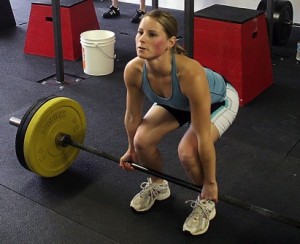Olympic lifting With Young Athletes

By Wil Fleming
There is a large portion of coaches that don’t think Olympic lifting has any benefits whatsoever. These coaches believe that the benefits of Olympic lifting is over blown, inflated and doesn’t really pertain to athletes. They cite the time it takes to teach athletes the lifts (too long they say), and they cite risk vs. reward (they say the risk is too great for too little reward). This post is not for those coaches, if you are one of those coaches, then I applaud you for creating more explosive, faster and more dominant athletes while not using Olympic lifts. This post is for the coaches that are using Olympic lifting or on the fence about these lifts, that need more ammunition when discussing their programs or want a final piece of the puzzle to commit to training their athletes with these lifts.
Type II muscle development
Type II (Fast twitch) muscle fiber is the golden currency for successful athletes. Greater type II muscle makes athletes more explosive, and faster. Type II muscle fibers are part of high threshold motor units and only react to high output activities, so curls with the 25 lbs dumbbells are not going to cut it. Olympic lifting uses high power movements and recruits type II muscle for activation, the more explosive movement is used the more preferentially these units will be recruited. There are movements that replicate the power output of Olympic lifts, but don’t hit on all the other great parts of Olympic lifting.
Improved coordination
The Olympic lifts are a great display of coordination and motor skill for all athletes. There is a precise control of the body that is necessary to complete these lifts. While this coordination is not identical to that required by any other sport nothing else in the weightroom is an identical match to sporting events either. This coordination does center around the hips and legs, similar to many other sporting events.
Improved power characteristics
The completion of the Olympic lifts includes full extension of the hips and knees in an explosive manner. This improvement has great carryover to hip and knee extension power in other areas of athletics. Athletes that are trained extensively in the Olympic lifts show improved rates of force development which greatly improves their power creating ability.
Improved force absorption
Often overlooked, receiving the bar overhead or at the chest requires the athlete to absorb force. This is the piece of the puzzle that can really make the Olympic lifts something that keeps athletes healthier. Most displays of power in the field of play must have a corresponding need to absorb force upon landing, Olympic lifts above other displays of power in the gym can provide this.
Success elsewhere
If you own a private facility the fact of the matter is, your high school athletes are probably doing another program at their high school. That program likely contains an Olympic lifting of some sort (probably power cleans). If you are not going to teach them how to power clean or hang clean, then you are just relying on someone else to do it for you. To give your athletes the best chance of success it is imperative that a qualified coach teaches them how to lift.
There are some young athletes with whom I do not use Olympic lifting with. Those athletes that have a history of back pain or back injuries would be first among them. For young athletes (12-14) I teach the Olympic lifts only as a skill, something to be improved upon by repetition not by weight used. For other athletes that are able, the Olympic lifts can serve a great role.


[…] September 10th, Wil Fleming wrote a very powerful article on “Olympic Lifting” that I found very thought […]